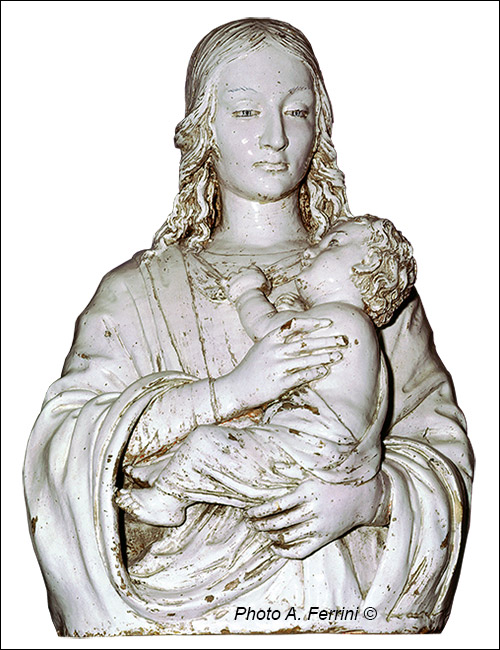Carda
in Casentino, una bella valle Toscana che puoi conoscere in ogni suo dettaglio con questo sito
Italiano
UNA MADONNA DELLA VALDICHIANA
Questa elegante Madonna con Bambino in terracotta invetriata, posta a decoro dell'altare maggiore della Chiesa di Carda, agli inizi degli anni Duemila è stata definitamente attribuita a Santi Buglioni. La sua realizzazione è databile attorno al 1520.
La storia di questa opera d'arte fiorentina è molto travagliata e caratterizzata da spostamenti non previsti e sicuramente turbolenti. Questa Vergine non fu realizzata per la Chiesa delle Sante Flora e Lucilla di Carda, forse sarebbe stata un'opera troppo preziosa per questo modesto borgo. Come arrivò in questo luogo lo racconta Don Francesco Fabbri in un suo scritto del 1701. È probabili che il parroco metta per scritto quanto riportato oralmente fino a quel momento, ossia un fatto di un secolo e mezzo prima, esattamente del 1554. Fu questo l'anno della famosa quanto cruenta Battaglia di Scannagallo che si combatte tra le truppe ispano fiorentine da una parte e quelle franco senesi dall'altra nei pressi di Marciano della Chiana, in un luogo attraversato da un corso d'acqua detto "Fosso di Scannagallo", da qui il nome della battaglia. Nello scontro che avvenne il 2 agosto perirono migliaia di soldati, quasi tutti appartenenti alle truppe franco senesi che subirono una pesantissima sconfitta. La battaglia non portò solo morti, ma anche distruzione. Tra le rovine di una non precisata chiesa fu trovata, da uomini del "Castello di Garda" che erano arruolati nell'esercito ispano fiorentino, questa bella Madonna che era rimasta miracolosamente intatta. Al termine della battaglia i soldati di Carda fecero ritorno al loro paese portando con sè il prezioso ritrovamento che fu posto a decoro dell'altare maggiore della chiesa che allora si trovava dove oggi è esposto il polittico quattrocentesco.
La storia travagliata di questa "Bianca Vergine" non termina qui. Nella notte tra il 6 e 7 ottobre 1975 la Madonna fu rubata. Il misfatto provocò un immenso dolore nel popolo di Carda fortemente affezionato a questa sacra figura da oltre quattro secoli. La speranza di poter ritrovare questa preziosa opera non si spense mai nel cuore delle persone di Carda, ma la possibilità che ciò si avverasse era considerata quasi nulla. Invece ecco il miracolo. Dopo ventiquattro anni, nell'agosto del 1999, arriva a Carda la notizia che la Vergine con Bambino era stata ritrovata e si trovava a Firenze. Il 23 ottobre fece il suo ritorno a Carda e tra grandi festeggiamenti fu rimessa al suo posto dove oggi possiamo ammirarla.
This elegant Madonna and Child in glazed terracotta, placed as a decoration on the high altar of the Church of Carda, was definitively attributed to Santi Buglioni at the beginning of the 2000s. Its creation can be dated around 1520.
The history of this Florentine work of art is very troubled and characterized by unforeseen and certainly turbulent movements. This Virgin was not created for the Church of Saints Flora and Lucilla of Carda, perhaps it would have been too precious a work for this modest village. How he arrived in this place is told by Don Francesco Fabbri in a writing of his from 1701. It is likely that the parish priest wrote down what had been reported orally up to that point, that is, a fact from a century and a half earlier, exactly from 1554. This was the year of the famous and bloody Battle of Scannagallo fought between the Spanish-Florentine troops on one side and the French-Sienese troops on the other near Marciano della Chiana, in a place crossed by a watercourse called "Fosso di Scannagallo", hence the name of the battle. In the clash that took place on August 2, thousands of soldiers died, almost all belonging to the French-Sienese troops who suffered a heavy defeat. The battle did not only bring deaths, but also destruction. Among the ruins of an unspecified church, this beautiful Madonna was found by men from the "Castello di Garda" who were enlisted in the Spanish-Florentine army, which had miraculously remained intact. At the end of the battle, the soldiers of Carda returned to their town, bringing with them the precious find that was placed to decorate the high altar of the church that was then located where the fifteenth-century polyptych is exhibited today.
The troubled history of this "White Virgin" does not end here. On the night between 6 and 7 October 1975, the Madonna was stolen. The crime caused immense pain to the people of Carda who had been deeply attached to this sacred figure for over four centuries. The hope of finding this precious work never died in the hearts of the people of Carda, but the possibility of this coming true was considered almost zero. Instead, here is the miracle. After twenty-four years, in August 1999, the news reached Carda that the Virgin with Child had been found and was in Florence. On 23 October it returned to Carda and amid great celebrations it was put back in its place where we can admire it today.

















































